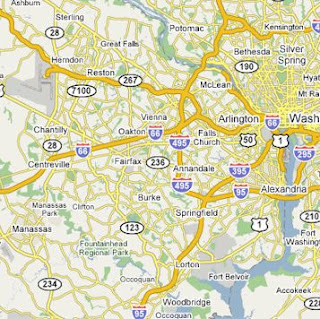But 50 years from now, when some historian chronicles the evolution of Virginia’s transportation policy, the most significant development of the 2000s won’t be the construction of the Springfield Bypass, or the house-cleaning of VDOT finances, or even the Comprehensive Transportation Funding and Reform Act of 2007. It will be the introduction of congestion pricing to Northern Virginia’s major transportation arteries.
There is a grand strategy, and Secretary of Transportation Pierce Homer is the architect. Look at a map of Northern Virginia. There are four major transportation corridors: the Interstate 495 Beltway, Interstates 95/295, Interstate 66, and the Dulles Toll Road. As Bacon’s Rebellion intern Lyle Solla-Yates writes in “Coming to an Interstate Near You,” variable-pricing HOT lanes are planned for the Beltway and I-95/395. Limited service could begin as early as late next year.
But that’s not all. Virginia’s HOT lanes will dovetail with Beltway HOT lanes planned in Maryland. Variable pricing also could be coming to the Dulles Toll Road, and Homer confirms that congestion pricing on the I-66 corridor is in the early stages of discussion. In each case (in Virginia at least), the HOT lane projects will be financed and administered by public-private partnerships. The tolls will add new capacity, and in the case of 95/395 will support Bus Rapid Transit.
Congestion tolls are the future of transportation. They are more than a tool for financing the expansion of transportation capacity: they simultaneously modulate demand. By using the price mechanism to allocate scarce rush-hour roadway capacity, they encourage drivers to seek alternatives — shifting their commuting schedules, changing routes, telecommuting, ride sharing, taking mass transit or pursuing other options.
Virginia needs to upgrade its transportation network, but the state cannot afford to accommodate every uptick in potential demand. We need a transportation system that addresses both the supply and demand sides of the equation. HOT lanes do that, and Pierce Homer will be remembered as the man who championed them.
It’s a shame that the public understanding of Virginia’s grand strategy is so limited because important issues are going unexplored. As huge a fan as I am of congestion pricing, I do have concerns: To what extent will HOT lanes open up new frontiers for real estate development? Will they act as an accelerant to “sprawl” (scattered, disconnected, low-density development) or as a retardant? How expensive will it be to upgrade the winding country roads serving that new development, and who will pay for it? I don’t know the answers. Nobody does.



